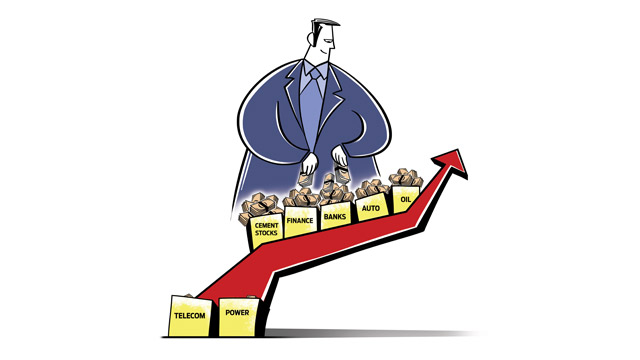
Mutual fund managers claim not to follow herd mentality, yet overall numbers tell a different story. An analysis of equity mutual funds' sector choices or exposure shows that over the past five years finance, banking, cement, auto, construction projects and consumer durables have witnessed a sharp rise in MF exposure.
These sectors, which closely track the consumer economy, have seen an incremental rise as fund managers positioned themselves for earnings/valuation growth, in line with fatter consumer wallets. Aspirations of the average Indian consumer underwent a shift in the past half a decade with people opting to buy automobiles, houses and durables often backed by finance.
Consider the finance sector. Mutual funds put in about ₹ 8,500 crore in these stocks in July 2011, with the sector accounting for 4.26% of equity assets under management (AUM). Five years down the line, the finance sector is still a big bet for mutual funds with nearly ₹ 33,000 crore of exposure and accounting for nearly 8% of equity AUM, shows data by Securities and Exchange Board of India (Sebi).
Banking remains the biggest sector. MF exposure stood at 16.96% five years ago and this has only strengthened. Today, lenders account for nearly 20% of equity AUM or two rupees out of every ten spent by the fund managers. Of course, today MFs are inclined towards private sector banks compared to the state-run lenders due to the rising bad loan problem for the public sector banks. In fact, the total market value of NBFC stocks is almost double that of the PSU banks.
"PSU Banks do seem statistically cheap but it is tough to figure out how many of them will recapitalise themselves and grow. Meanwhile, the opportunity is ripe for other banks / NBFCs to capture market share and growth opportunities. The earnings growth is driven by both availabilities of capital and the business cycle," said Rajeev Thakkar, CIO, PPFAS Mutual Fund.
Sectors like cement, auto, construction project, consumer durables, transportation and chemicals have seen overall MF exposure go up by 0.93 percentage points to 2.58 percentage points. The automobile sector is taken as a proxy for the economy. After a brief lull, auto sales are again back with a bang. "Passenger vehicle sales registered a scorching growth of 16% for the month of August which is the loudest signal on the health of the economy. This is one macroeconomic signal which is infallible in estimating the vibrancy in the economy. The bull case scenario based on passenger vehicle sales is the most reliable indicator of the Indian stock market since the last three decades," opines Jimeet Modi, CEO, Samco Securities.
It is important to understand that equity AUM grew by leaps and bounds during the past five years. At the end of July 2011, equity AUM stood at 2.01 lakh crore. With a huge gush of inflows and stocks zooming upward, for instance, just in one year investors pumped in over ₹ 85,000 crore into equity funds in 2015. All this money flowed into the stock markets as most fund managers do not take cash calls. Imagine the effect over 5 years. The benchmark Sensex galloped from 18200 levels at July-end of 2011 to 28000 at the end of July-2016.
So, it is interesting to find out which sectors lost favor. The analysis of Sebi data shows that MFs exposure saw the steepest cut in oil space. The past 12-18 months have been particularly trying times for oil companies with the fall of crude to decadal low levels. Exposure has dropped from 3.21% to less than 0.7% in five years.
Telecom services stocks have also been under pressure, buckling under the weight of strict regulations, debt, falling average revenue per user and competition. Mutual funds held 3.56% of their overall equity AUM in telecom services stocks in 2011. That exposure has slowed down to a mere 1.26%. Fund managers' call on telecom has been right. With the advent of Reliance Jio, listed stocks like Bharti Airtel and Idea have faced some punishment and things might be topsy-turvy even going ahead. ICICI Securities said, "The key thing to watch would be the impact on Bharti/Idea's high ARPU subscribers, and the likely ARPU accretion from the migration of 2G data subscribers and expanding data users from Q4FY17."
Mutual Funds have also shown resistance to stocks related to gas, petroleum products, precious metals, industrial capital goods and power. Individual exposure in these sectors has come down by 1.5-2.2 percentage points.
The original article could be seen here.
